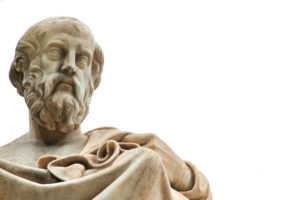Exploring Leadership Through Plato’s Republic
In his introduction to Athanasius’ On the Incarnation, C.S. Lewis recommended reading old books. He contended, “ Every age has its own outlook. It is specially good at seeing certain truths and specially liable to make certain mistakes. We all, therefore, need the books that will correct the characteristic mistakes of our own period. And that means the old books.” [1] With that said, the challenge to explore the topic of leadership in a work that has been in print for over 300 years was both intimidating and exciting. I turned to Plato and one of the most magnificent treatises on philosophy, politics, and education, The Republic.[2]
He wrote extensively on ethics and political philosophy with a focus on leadership. He explored the character and nature of good leaders, how they should be trained, and what kind of leaders to avoid. While sometimes very complex, he is very good at appealing to readers’ intuitions and sparking their imagination, especially when addressing leadership.
This can be seen in his use of different leadership models throughout his works, such as the doctor, the captain, the artist, the teacher, the weaver, the sower, and the shepherd. In this post, I will focus on Plato’s treatment of one of the oldest leadership models, the shepherd.
The Republic: In Brief
In The Republic, Plato explores the nature of justice, the ideal society, and the role of the philosopher-king in creating and leading a just society. Plato uses a philosophical dialogue with Socrates and several others as the vehicle of this exploration. The model of the shepherd is first introduced in Book 1 during an exchange between Socrates and Thrasymacus. It is briefly addressed again in books III and VI.
The Shepherd Model
Through the shepherd model, Plato suggests that just as a shepherd cares for his flock by ensuring their well-being and guiding them, a true leader should care for those they lead, prioritizing their welfare by caring, guiding, and directing with particular knowledge, expertise, and selflessness.
The Challenges
However, the model is not without challenges. In Book I, when it is first introduced, Thrasymacus challenges Socrates by saying:
“You suppose shepherds or cowherds consider the good of the sheep or the cows and fatten them and take care of them looking to something other than their masters’ good and their own; and so you also believe that the rulers in the cities, those who truly rule, think about the ruled differently from the way a man would regard sheep, and that night and day they consider anything else than how they will benefit themselves.”[3]
Thrasymachus implies the shepherd is not as noble as Socrates suggests. He points out the reality that a shepherd is not ultimately looking out for the good of the sheep but is taking care of them so that, eventually, they can be sheered or slaughtered for the ultimate benefit of the shepherd. In this way, the leader, as a shepherd, exploits their followers for personal gain. Taken to an extreme, this gives us the figure of the tyrant. In response, Socrates contends that the moment a shepherd stops caring only for the good of the sheep, they become something other than a shepherd. Socrates doesn’t refute Thrasymachus’ challenge further and just moves on. Later in Book VIII, Plato deals more extensively with the danger of the tyrants and how they come to power, which is a fascinating concept given our current political moment.
In the book Models of Leadership in Plato and Beyond, Dominic Scott and R. Edward Freeman examine Plato’s use of the shepherd model and point out Plato’s challenge against it in another of his books, the Statesman.[4] Comparing a leader to a shepherd suggests a significant separation between leaders and followers since the shepherd is not a sheep in the analogy but a different kind of creature altogether. For Plato, the shepherd model would work if the leader were a divine being leading humans.[5] Some degree of separation is necessary, as seen in Friedman’s model of well-differentiated leadership; [6] however, for Plato, the shepherd model may take it too far, or does it.
The Solution
The shepherd model only works for Plato if it depicts a divine being leading humans. In John 10, Jesus makes it clear that he is the Good Shepherd. Jesus is the only example of shepherding that could satisfy Plato. A good shepherd lays down his life for his sheep, unlike a bad shepherd, who, like a tyrant, exploits the sheep and ultimately consumes them. Jesus states that those who consume sheep are wolves, and those who stop caring for the sheep are not shepherds but hired hands who care more for their own well-being than that of the sheep. 
According to Plato, good and bad shepherds are analogous to good and bad leaders. The difference lies in the priority of concern. A good leader shows selflessness in prioritizing concern for the good of those they lead, while a bad leader is self-concerned.
If space allowed, I would love to explore the leadership principles found in The Republic, which contain key Platonic components like his vision of the ideal ruler, the Philosopher-King, the leader’s role in guiding others out of ignorance in The Allegory of the Cave, and the interesting nuances of leadership in The Tripartite Soul.
________________________________________________________________________________________
[1] St. Athanasius the Great of Alexandria, On The Incarnation, Translated by John Behr, (Yonkers, NY: St. Vladimir’s Seminary Press, 2011), 10.
[2] Plato, The Republic of Plato, Translated by Allan Bloom. 2nd ed, (New York: Basic Books, 1968).
[3] Plato, The Republic of Plato, 21.
[4] Dominic Scott and R. Edward Freeman, Models of Leadership in Plato and Beyond, (Oxford, UK: Oxford Press, 2021).
[5] Scott and Freeman, Models of Leadership in Plato and Beyond, 105.
[6] Friedman, Edwin H., A Failure of Nerve: Leadership in the Age of the Quick Fix, (New York: Church Publishing Incorporated, 2017).
9 responses to “Exploring Leadership Through Plato’s Republic”
Leave a Reply
You must be logged in to post a comment.

Hi Chad. I was hoping someone would write on Plato! I wasn’t brave enough to take on that challenge. Thank you. I appreciated your focus on the shepherding model and the challenge Thrasymachus presents Socrates. I was reminded of Simon Walker’s ideas concerning the leadership-followership collusion cycle and the need for the leader to have followership approval. As someone in a shepherding position, how do you ‘check yourself’ to ensure your motives for leading are for the benefit of the flock?
Elysse, your question is a great one! Checking motives is an everyday challenge. What has helped me is thinking of my role more as a sheepdog than a shepherd. In this way, I maintain a mindset that I work for the Good Shepherd, serving his purposes for his sheep. I also try to lean into opportunities to sacrifice for the congregation and take meaningful risks. Thank you for the question.
Hi Chad,
I enjoyed your blog. Regarding Thrasymachus’ concern that shepherd leaders are not as upstanding as one might think, what do you see as a solution to safeguard against leaders “[exploiting] their followers for personal gain?”
Kari, thanks for the question. For me, it begins with the properly framed perspective that Jesus is the Good Sheperd. The sheep are not mine but his.
Chad, I appreciate this description of “The Republic” because it’s one of those books we hear about a lot… but which I haven’t yet had a chance to read.
Your choice of the Shepherd as Leader is very interesting to me. Do you think Plato could have understood Jesus’s description of himself as the Good Shepherd? (Conjecture, I know.)
And what about the fact that pastors are considered “shepherds” for their congregational “flocks”? How might pastors use this information? How might you use this analogy, going forward, as a pastor? And what other applications might there be, outside of pastoral shepherding?
Thanks Chad for your post and exploration of this traditionally biblical metaphor of leadership from an extra-biblical perspective.
How do you reconcile these things as a leader in your church where shepherding is a common metaphor? How do you point people to the Good Shepherd while also caring for “the flock”? Asking for a friend…
Hey Chad! You know as a shepherd I was definitely attracted to your post and truly appreciated your book selection. You mentioned; “A good leader shows selflessness in prioritizing concern for the good of those they lead, while a bad leader is self-concerned.”
What would select as the primary obstacle in shepherds losing concern with the people and prioritizing self?
Chad, thanks for this. My NPO has led me to the work on Robert Greenleaf on Servant Leadership. The weakness of the Shepherd model that Plato raises is the same critique of the Greenleaf model. However, his model has influenced many of the modern day leadership theories and approaches.
I also appreciate the you brought in John 10.
As undershepherds of the Great Shepherd, how might pastoral leaders avoid the pitfalls of the shepherd model?
I am going to try and reply to Graham, Daren, Debbie, and Ryan at once since your questions seem to have a similar response. The term “pastor” actually derives from the metaphor of “shepherd.” I think the great challenge for those pastoring churches under the leadership of the Great Shepherd is to maintain the mindset and regular reminders that the sheep (congregation) are Christ’s sheep and not our own. We are stewards of HIS flock. When we start to take ownership of the sheep, I think there is a temptation to rationalize ways to take advantage of the sheep or the position of shepherd for personal gain. I think the primary lesson from Plato is that a shepherd stops being a shepherd when the well-being of the sheep stops being the priority. I think a practical step towards this is begin each day in conversation with Jesus “What are we doing with the sheep today? Where do you want me to take them? How do you want me to love them?”